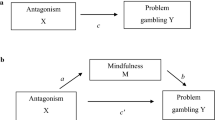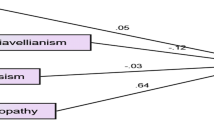Abstract
The present study aimed to explore the unique and common role that some cognitive, personality and relational characteristics play in male adolescents’ regular gambling behavior. Participants were 273 male adolescents and young adults aged 15–19 recruited in sports betting centers. They completed the South Oaks Gambling Screen, the Narcissistic Admiration and Rivalry Questionnaire, the Hypercompetitive Attitude scale, and The Coping Strategy Indicator. The relationship between narcissistic rivalry and gambling was mediated by hyper-competitiveness and avoidant coping strategy. These findings suggest that narcissistic features and maladaptive coping strategies might be involved in the development of disordered gambling in youth, supporting a compensatory model of this addictive behavior and claiming for preventative actions that take into account the psychological vulnerabilities of adolescents and young adults.


Similar content being viewed by others
References
Afifi, T. O., Brownridge, D. A., MacMillan, H., & Sareen, J. (2010). The relationship of gambling to intimate partner violence and child maltreatment in a nationally representative sample. Journal of Psychiatric Research, 44(5), 331–337.
American Psychiatric Association. (2013). Diagnostic and statistical manual of mental disorders (5th ed.). Washington, DC: American Psychiatric Association.
Back, M., Küfner, A. C. P., Dufner, M., Gerlach, T. M., Rauthmann, J. F., & Denissen, J. J. A. (2013). Narcissistic admiration and rivalry: Disentangling the bright and dark sides of narcissism. Journal of Personality and Social Psychology, 105, 1013–1037.
Bergevin, T., Gupta, R., Derevensky, J., & Kaufman, F. (2006). Adolescent gambling: Under-standing the role of stress and coping. Journal of Gambling Studies, 22, 195–208.
Bilevicius, E., Neufeld, D. C., Single, A., Foot, M., Ellery, M., Keougha, M. T., et al. (2019). Vulnerable narcissism and addiction: The mediating role of shame. Addictive Behaviors, 92, 115–121.
Blaszczynski, A., & Nower, L. (2002). A pathways model of problem and pathological gambling. Addiction, 97, 487–499.
Burger, T. D., Dahlgren, D., & MacDonald, C. D. (2006). College students and gambling: An examination of gender differences in motivation for participation. College Student Journal, 40(3), 704–714.
Canale, N., Griffiths, M. D., Vieno, A., Siciliano, V., & Molinaro, S. (2016). Impact of Internet gambling on problem gambling among adolescents in Italy: Findings from a large-scale nationally representative survey. Computers in Human Behavior, 57, 99–106.
Cain, N. M., Pincus, A. L., & Ansell, E. B. (2008). Narcissism at the crossroads: Phenotypic description of pathological narcissism across clinical theory, social/personality psychology, and psychiatric diagnosis. Clinical Psychology Review, 28(4), 638–656.
Calado, F., Alexandre, J., & Griffiths, M. D. (2017). Prevalence of adolescent problem gambling: A systematic review of recent research. Journal of Gambling Studies, 33, 397–424.
Compas, B. E., Connor-Smith, J. K., Saltzman, H., Thomsen, A. H., & Wadsworth, M. (2001). Coping with stress during childhood and ado-lescence: Problems, progress, and potential in theory and research. Psychological Bulletin, 127, 87–127.
Cramer, P. (2011). Young adult narcissism: A 20 year longitudinal study of the con-tribution of parenting styles, preschool precursors of narcissism, and denial. Journal of Research in Personality, 45(1), 19–28.
Di Blasi, M., Giardina, A., Lo Coco, G., Giordano, C., Billieux, J., & Schimmenti, A. (2020). A compensatory model to understand dysfunctional personality traits in problematic gaming: The role of vulnerable narcissism. Personality and Individual Differences, 160, 109921. https://doi.org/10.1016/j.paid.2020.109921.
Dickinson, K. A., & Pincus, A. L. (2003). Interpersonal analysis of grandiose and vulnerable narcissism. Journal of Personality Disorders, 17(3), 188–207.
Dickson, L., Derevensky, J. L., & Gupta, R. (2008). Youth gambling problems: Examining risk and protective factors. International Gambling Studies, 8, 25–47.
Dowling, N. A., Cowlishaw, S., Jackson, A. C., Merkouris, S. S., Francis, K. L., & Christensen, D. R. (2015). The prevalence of comorbid personality disorders in treatment-seeking problem gamblers: A systematic review and meta-analysis. Journal of Personality Disorders, 29(6), 735–754.
Floros, G. D. (2018). Gambling disorder in adolescents: Prevalence, new developments, and treatment challenges. Adolescent Health, Medicine and Therapeutics, 9, 43–51.
Grant, J. E., Odlaug, B. L., & Chamberlain, S. R. (2016). Neural and psychological underpinnings of gambling disorder: A review. Progress in Neuropsychopharmacology and Biological Psychiatry, 65, 188–193.
Griffiths, M. D. (1995). Adolescent gambling. London, UK: Routledge.
Gupta, R., & Derevensky, J. L. (2000). Adolescents with gambling problems: From research to treatment. Journal of Gambling Studies, 16, 315–342.
Jacobs, D. (1986). A general theory of addictions: A new theoretical model. Journal of Gambling Behavior, 2, 15–31.
Johansson, A., Grant, J. E., Won Kim, S., Odlaug, B. L., & Götestam, K. G. (2009). Risk factors for problematic gambling: A critical literature review. Journal of Gambling Studies, 25(1), 67.
Kardefelt-Winther, D., Heeren, A., Schimmenti, A., van Rooij, A., Maurage, P., Carras, M., et al. (2017). How can we conceptualize behavioural addiction without pathologizing common behaviours? Addiction, 112(10), 1709–1715.
Kaufman, S. B., Weiss, B., Miller, J. D., & Campbell, W. K. (2018). Clinical correlates of vulnerable and grandiose narcissism: A personality perspective. Journal of Personality Disorders, 34, 107–130.
Lesieur, H. R., & Blume, S. B. (1987). The South Oaks Gambling Screen (SOGS): A new instrument for the identification of pathological gamblers. The American Journal of Psychiatry, 144, 1184–1188.
Lynn, R. (1993). Sex differences in competitiveness and the valuation of money in twenty countries. Journal of Social Psychology, 133, 507–511.
Marget, N., Gupta, R., & Derevensky, J. (1999). The psychosocial factors underlying adolescent problem gambling. Boston: Poster presented at the annual meeting of the American Psychological Association.
Miller, J. D., Dir, A., Gentile, B., Wilson, L., Pryor, L. R., & Campbell, W. K. (2010). Searching for a vulnerable dark triad: Comparing factor 2 psychopathology, vulner-able narcissism, and borderline personality disorder. Journal of Personality, 78(5), 1529–1564.
Monaghan, S., & Blaszczynski, A. (2009). Impact of mode of display and message content of responsible gambling signs for electronic gaming machines on regular gamblers. Journal of Gambling Studies, 26(1), 67–88.
Neale, P., Delfabbro, P., & O’Neil, M. (2005). Problem gambling and harm: Towards a national definition. Melbourne: Gambling Research Australia.
Nigro, G. (1996). Coping strategies and anxiety in Italian adolescents. Psychological Reports, 79, 835–839.
Nower, L., Derevensky, J., & Gupta, R. (2004). The relationship of impulsivity, sensation seeking, coping and substance use in youth gamblers. Psychology of Addictive Behaviors, 18, 49–55.
Pace, U., D’Urso, G., & Zappulla, C. (2018). adolescent effortful control as moderator of father's psychological control in externalizing problems: A longitudinal study. Journal of Psychology: Interdisciplinary and Applied, 152, 164–177.
Pace, U., & Passanisi, A. (2018). Maladaptive personality traits and thinking styles among adolescent regular gamblers: A moderator mediation model. Personality and Individual Differences, 132, 108–114.
Pace, U., Schimmenti, A., Zappulla, C., & Di Maggio, R. (2013). Psychological variables characterizing different types of adolescent gamblers: A discriminant function analysis. Clinical Neuropsychiatry, 10(6), 253–259.
Pace, U., & Zappulla, C. (2013). Detachment from parents, problem behaviors, and the moderating role of parental support among Italian adolescents. Journal of Family Issues, 34, 768–783.
Passanisi, A., D’Urso, G., & Pace, U. (2019). The interplay between maladaptive personality traits and mindfulness deficits among adolescent regular gamblers: a mediation model. Journal of gambling studies, 35(1), 93–105.
Passanisi, A., & Pace, U. (2017). The unique and common contributions of impulsivity and decision-making strategies among young adult Italian regular gamblers. Personality and Individual Differences, 105, 24–29.
Passanisi, A., Pace, U., & Craparo, G. (2017). Magical thinking and decision-making strategies among late adolescent regular gamblers: A mediation model. Journal of Adolescence, 59, 51–58.
Paulhus, D. L., & Williams, K. M. (2002). The dark triad of personality: Narcissism, machiavellianism, and psychopathy. Journal of Research in Personality, 36, 556–563.
Pellerone, M., Cascio, M., Costanzo, G., Gori, A., Pace, U., & Craparo, G. (2017). Alexithymia and psychological symptomatology: Research conducted on a non-clinical group of Italian adolescents. International Journal of Culture and Mental Health, 10, 300–309.
Pincus, A. L., Ansell, E. B., Pimentel, C. A., Cain, N. M., Wright, A. C., & Levy, K. N. (2009). Initial construction and validation of the pathological narcissism inventory. Psychological Assessment, 21(3), 365–379.
Pincus, A. L., & Lukowitzky, M. R. (2010). Pathological narcissism and narcissistic personality disorder. Annual Review of Clinical Psychology, 6, 421–446.
Povoledo, E. (2013). Fears of social breakdown as gambling explodes in Italy. The New York Times. Retrieved January 19, 2013, from https://www.nytimes.com/2013/12/29/world/europe/fears-of-social-breakdown-as-gambling-explodes-in-italy.html?hp.
Preacher, K. J., & Hayes, A. F. (2008). Asymptotic and resampling strategies for assessing and comparing indirect effects in multiple mediator models. Behavior research methods, 40(3), 879–891.
Quilty, L. C., Watson, C., Robinson, J. J., Toneatto, T., & Bagby, R. M. (2011). The prevalence and course of pathological gambling in the mood disorders. Journal of Gambling Studies, 27, 191–201.
Rogier, G., & Velotti, P. (2018). Narcissistic implications in gambling disorder: The mediating role of emotion dysregulation. Journal of Gambling Studies, 34, 1241–1260.
Ryckman, R. M., Libby, C. R., van den Borne, B., et al. (1997). Values of hypercompetitiveness and personal development competitive individuals. Journal of Personality Assessment, 69(2), 271–283.
Sharpe, L. (2002). A reformulated cognitive-behavioral model of problem gambling: A biopsychosocial perspective. Clinical Psychology Review, 22(1), 1–25.
Tackett, J., Rodriguez, L., Rinker, D., Neighbors, C., Tackett, J. L., Rodriguez, L. M., et al. (2015). A personality-based latent class analysis of emerging adult gamblers. Journal of Gambling Studies, 31(4), 1337.
Thombs, D. L., Olds, R. S., Bondy, S. J., Winchell, J., Baliunas, D., & Rehm, J. (2009). Undergraduate drinking and academic performance: A prospective investigation with objective measures. Journal of Studies on Alcohol and Drugs, 70(5), 776–785.
Tobin, S. J., Loxton, N. J., & Neighbors, C. (2014). Coping with causal uncertainty through alcohol use. Addictive Behaviors, 39(3), 580–585.
Trombly, D. R. C., & Zeigler-Hill, V. (2017). The dark triad and disordered gambling. Current Psychology, 36(4), 740–746.
Vecchione, M., Dentale, F., Graziano, M., Dufner, M., Wetzel, E., Leckelt, M., et al. (2018). An Italian validation of the narcissistic admiration and rivalry questionnaire (NARQ): Further evidence for a two-dimensional model of grandiose narcissism. Applied Psychology Bulletin, 281(67), 29–37.
Volberg, R. A., Gupta, R., Griffiths, M. D., Olason, D. T., & Delfabbro, P. (2010). An internation-al perspective on youth gambling prevalence studies. International Journal of Medicine and Health, 22(1), 3–38.
Walker, R., & Stephens, R. S. (2014). Protective behavioral strategies mediate problem-focused coping and alcohol use in college students. Addictive Behaviors, 39(6), 1033–1037.
Wink, P. (1991). Two faces of narcissism. Journal of Personality and Social Psychology, 61(4), 590–597.
Funding
Authors declare that no funds were received for the present study.
Author information
Authors and Affiliations
Corresponding author
Ethics declarations
Conflict of interest
The authors declare that they have no conflict of interest.
Ethical Approval
All procedures performed in studies involving human participants were in accordance with the ethical standards of the institutional and/or national research committee and with the 1964 Helsinki declaration and its later amendments or comparable ethical standards.
Informed Consent
Informed consent was obtained from all individual participants included in the study.
Additional information
Publisher's Note
Springer Nature remains neutral with regard to jurisdictional claims in published maps and institutional affiliations.
Rights and permissions
About this article
Cite this article
Pace, U., D’Urso, G., Ruggieri, S. et al. The Role of Narcissism, Hyper-competitiveness and Maladaptive Coping Strategies on Male Adolescent Regular Gamblers: Two Mediation Models. J Gambl Stud 37, 571–582 (2021). https://doi.org/10.1007/s10899-020-09980-z
Accepted:
Published:
Issue Date:
DOI: https://doi.org/10.1007/s10899-020-09980-z




